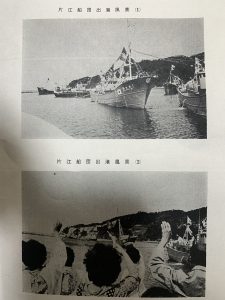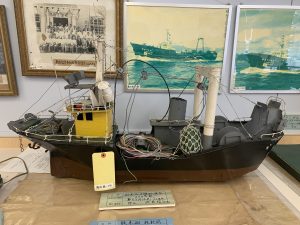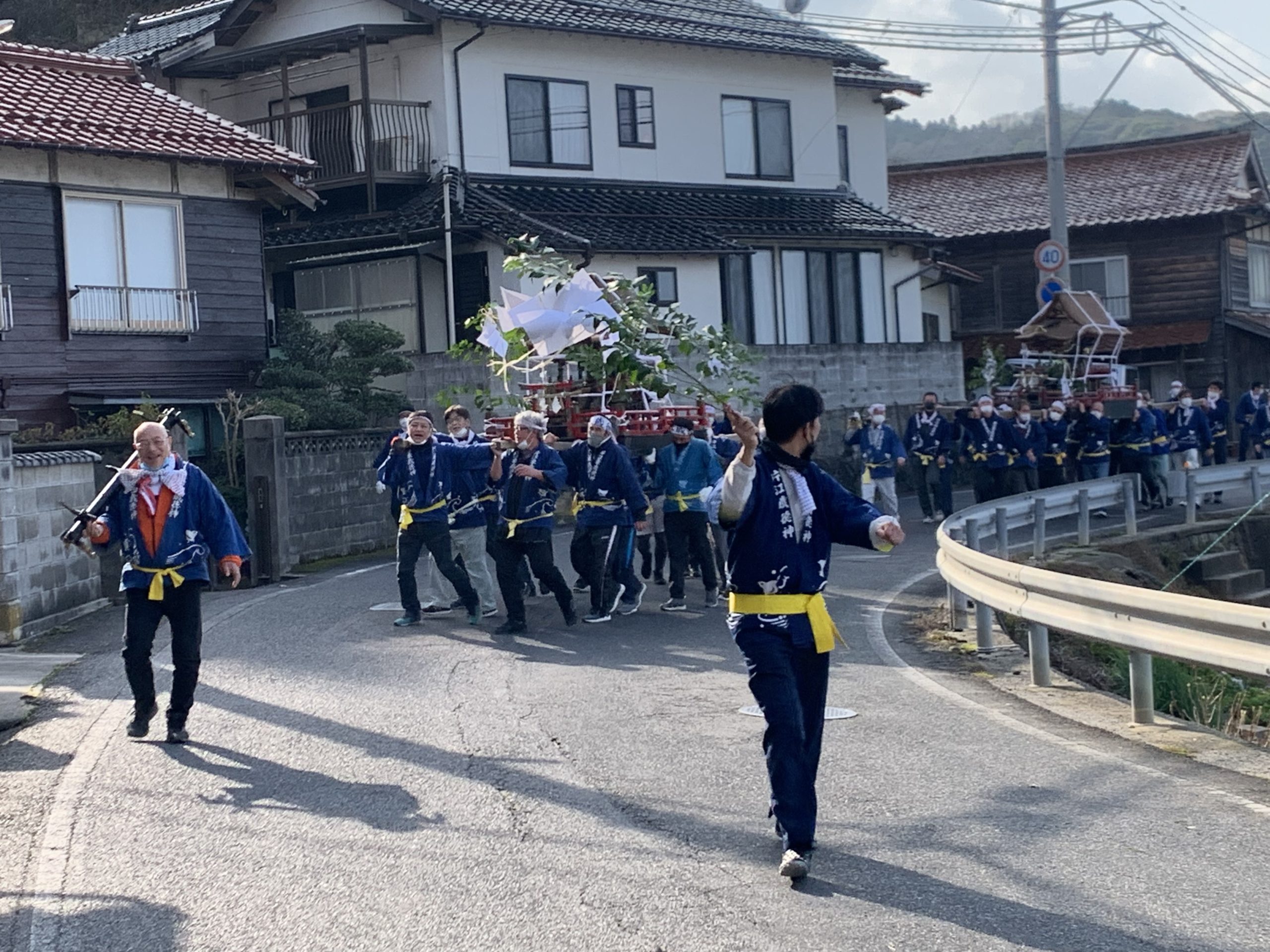Mihonoseki – On January 8th, a traditional Shinto ritual took place in Katae — a suburban hamlet of Matsue City in Shimane Prefecture sandwiched between the Miyano mountains and the Japan Sea coastline. The ancient Shimane prefectural record, the Izumo Fudoki, says the Japanese god Kunioshiwake named the land Katae.
The village is located in a remote area of the Shimane Peninsula, three hours by public transport from Tokyo (Haneda Airport). It takes 1.5 hours from Haneda Airport to Yonago Airport, then 20 minutes by JR Sakaiminato line or bus to Sakaiminato Station. Visitors should transfer to the Mihonoseki Community Bus bound for Ui Ferry Landing Stage for 10 minutes, then take a 15-minute bus ride to Katae Chuo.
Katae introduced an innovative fishing method – trawl fishing- to the Japanese fishing industry, using two motorized boats about 100 years ago, introduced by Kanehachi Shibutani. The hamlet was known for dispatching competent fishermen to western Japan’s Hamada, Shimonoseki, and Hakata ports. These fishermen were called the Katae Fishing Flotilla until the 1960s. The flotilla’s fishing boats were said to fill Katae Bay, going fishing as far as off Mainland China as an offshore fishery. Despite a shrinking scale of fisheries, the current less than 20 natives have carried on the tradition of an inshore fishery.


provided by Matsue City Hall

As the hamlet’s tradition, Katae Sumitsuke Tondo celebrates a new year, using black ink — a mixture of charcoal and alcohol — to paint participants’ faces. It sounds eccentric, but those who smear their faces with ink during the festival are said never to have a cold and encounter maritime accidents.
This year was the first event since the COVID-19 pandemic, which prevented the painting tradition. The festival’s uniqueness usually attracts many visitors yearly; even the BBC (British Broadcasting Corporation) reported on this event in 2010. Despite a smaller scale, participants enjoyed traditional performances this year.
The sea surface was greenish on a chilly morning at about 5C, with leaden skies because of the cold weather from Siberia. While warming at the fire, descendants of the Katae Fishing Flotilla set two bamboo towers decorated with sacred festoons, the first calligraphies of the year, and pairs of pine decorations, holy items for the Japanese to hail the new year. The towers hoisted former Katae flotilla fishing flags, telling the neighbourhood of the coming new year. A local myth says the god Kunioshiwake, officially a symbol of good harvest but also of good fishing for locals, would descend through the sanctuary towers during the new year period. The locals would come out of their houses to say New Year’s greetings.

At 11:00 a.m., parishioners gathered at Katae Shrine, dedicated to its guardian god Kunioshiwake, to pray for perfect health, familial safety, safe navigation, and good fishing. The current Katae Shrine is said to have been built before the 18th century, comprising a bright wooden main shrine and moss stone-made walls covered by the shadow of a hill, which creates a solemn atmosphere. Two female Shinto priests wearing black hats, white costumes, and sky blue pleated skirts read a Shinto prayer written in an unfathomable classic Japanese with their mezzo-soprano voices. Meanwhile, local community representatives offer sprigs of the sacred green sakaki tree in front of two portable shrines to breathe life into the god’s soul. The sublime moment kept participants keep silent and bowing their heads to respect the gods. On finishing the prayer, a taiko drum and bamboo flute resounded throughout the shrine, giving cups of sacred sake to carriers called ujiko to purify their bodies and minds. Then, oyato, the leader, said he hoped everyone would accomplish their mission without injuries.

Before noon, the two portable shrines — shouldered by those wearing the same uniforms — left the shine’s grounds, starting the parade. The uniforms, happi coats dyed azure, had a Katae mark with white Kanji letters, the same crest as the mark of Katae’s fishing boats. The temperature was severely cold, but all were enthusiastic, and the skies cleared. The shrines passed through the hamlet’s streets via the towers adjacent to the port and fish market. Despite no black ink paintings this year, sightseers enjoyed the parade, sake, and snacks. Finally, the shrines headed to a beach for purification by soaking in seawater. Touya, members of the local neighbourhood association, and just-married husbands were cast into the sea, which was very cold. This tradition Katae celebrates to honour the coming of the new year.

Helpful Link(About the festival)
Japan Endless Discovery (JNTO)
How to get to Katae( a part of Mihonoseki)
(Another route as above mentioned)
From JR Okayama Station on the Sanyo Shinkansen, take the Yakumo Limited Express to JR Matsue Station (2 hours and a half), then board the Ichibata Bus bound for Mihonoseki Bus Terminal (45 minutes). Transfer to the Mihonoseki Community Bus Shichirui Line and get off at “Katae Chuo” bus stop (12 minutes). Katae Shrine is 5 minutes on foot from the bus stop.
721 Katae, Mihonoseki-cho, Matsue-shi, Shimane-Prefecture


2 Replies to “Katae celebrates new year”